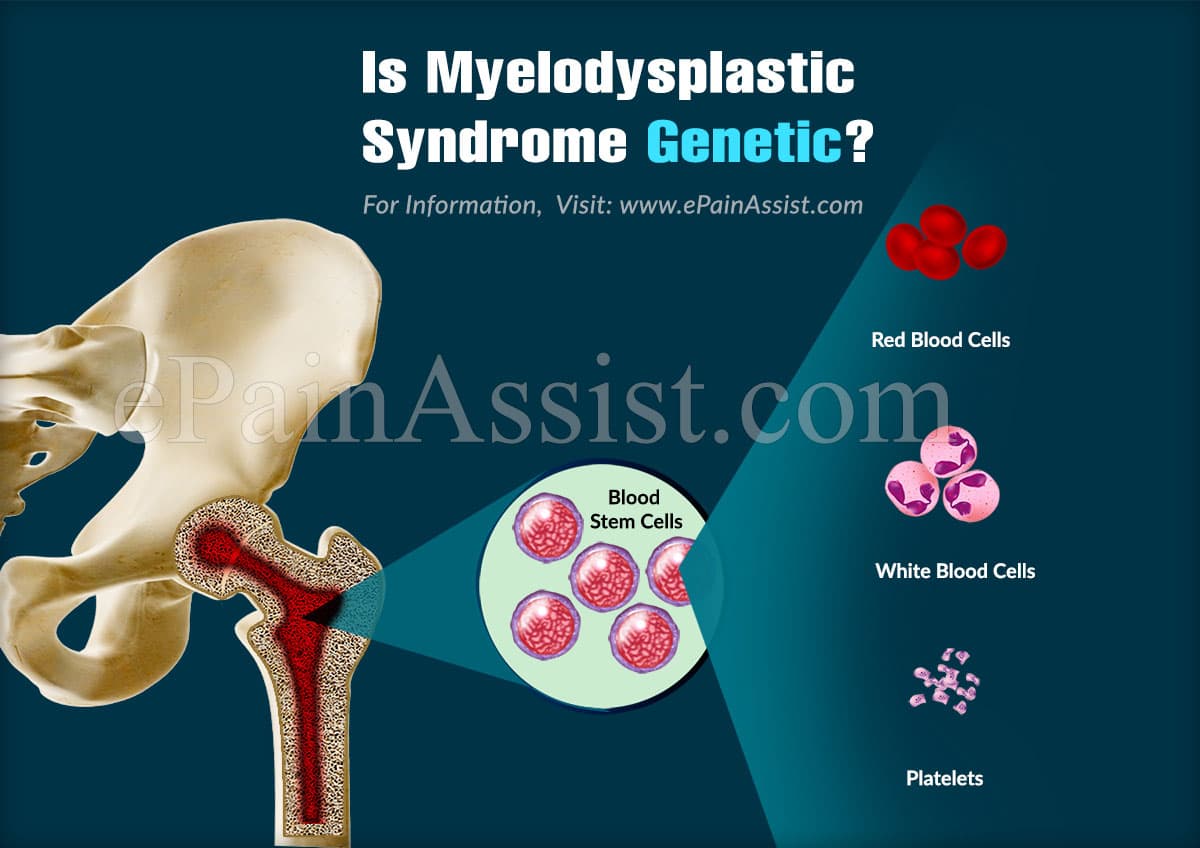Myelodysplastic syndrome is a group of malignancies in which the immature blood cells are unable to completely mature in the bone marrow and so they remain unhealthy or immature blood cells. Initially there are no symptoms for MSD, but as it grows, the following symptoms are visible:
- Tiredness
- Breathlessness
- Easy Bleeding
- Recurrent infections

Is Myelodysplastic Syndrome Genetic?
Generally the Myelodysplastic Syndrome or MSD is not genetically inherited; which means it does not pass from parents to their off-springs. Although in most of the cases, the change in genetic composition (which may occur due to any reason) increases the chances of developing myelodysplastic syndrome. There are some specific inherited genetic conditions and special genes involved which develop or increase the risk of myelodysplastic syndrome.(1)
However, to know more the genetics conditions and the genes involved for the development of myelodysplastic syndrome we first need to know how it is developed.
How Myelodysplastic Syndrome Is Developed?
A risk factor is something which increases the chances of developing a disease in a person. As it is stated earlier that although myelodysplastic syndrome is not inherited, but any risk factor which causes changes in the genes’ constitution may lead to the development of myelodysplastic syndrome. Just like other types of cancers there are various risk factors that are responsible for developing myelodysplastic syndrome.
When we talk of risk factors, it does not mean that they will necessarily develop the disease. Some people are exposed to several risk factors but they never develop myelodysplastic syndrome and some people who are not at all exposed to any risk factors develop the myelodysplastic syndrome. However, knowing about the risk factors and consulting them with the doctor will help you in maintaining a healthy lifestyle and making better health care choices. There are certain risk factors which may be responsible for development of myelodysplastic syndrome. These risk factors include:
Age– Myelodysplastic syndrome occurs mostly in people with 60 and above and is very rare in young people. In children it is rarest.
Gender– It is more common in males then in females.
Smoking– Smoking or consuming tobacco in any other form is a very common risk factor for the developing myelodysplastic syndrome.
Environmental Exposure– Continuous exposure to UV rays, or any such kind of environmental factors increase the risk of myelodysplastic syndrome.
Occupational Hazard– Those who are continuously in contact with chemicals like benzene, smoke, toxins, or insecticide are at a higher risk of developing myelodysplastic syndrome.
Prior Chemotherapy Or Radiation therapy– It is seen that around 20% of cancer patients who underwent radiation therapy or chemotherapy for treatment have developed myelodysplastic syndrome. This type of myelodysplastic syndrome is known as secondary myelodysplastic syndrome.
Genetics– Last but not the least, the genes that are mutated due to any reason increases the risk of developing myelodysplastic syndrome. However it is not inherited. There are genetic conditions which are listed below along with some specific genes which are responsible for developing myelodysplastic syndrome. (2)
Congenital Neutropenia (People with shortage of neutrophils)
Diamond Blackfan Anemia (defective bone marrow)
Fanconi Anemia (A bone marrow defect with low production of all types of blood cells)
Shwachman-Diamond Syndrome (uncommon congenital disease characterized by exocrine pancreatic deficiency, bone marrow defect, skeletal irregularity and short height.)
- Familial Aplastic Anemia (SRP72) (A chronic liver disease)
- Familial MDS/AML (GATA2, DDX41) (Platelet disorder)
- Thrombocytopenia 2 (ANKRD26)
- Thrombocytopenia 5 (ETV6)
Conclusion
Myelodysplastic syndrome is a group of cancers which is characterized by immature or underdeveloped blood cells that are unable to completely mature in the bone marrow. The Myelodysplastic Syndrome or MSD is not genetically inherited; but in many cases, the change in genetic composition or gene mutation occurring due to any reason increases the chances of developing myelodysplastic syndrome. There are certain risk factors which may be responsible for development of myelodysplastic syndrome, like age, gender, smoking, occupation hazards, environmental exposure etc. Also there are some genetic conditions along with specific genes which increase the risk of myelodysplastic syndrome.
Also Read:
- Coping with Myelodysplastic Syndromes & its Follow-Up Care
- How Do Myelodysplastic Syndrome Patients Die?
- How Long Can You Live With Myelodysplastic Syndrome?
- Is Myelodysplastic Syndrome A Fatal Disease?
- Recovery Period For Myelodysplastic Syndrome
- What Are Early Signs Of Myelodysplastic Syndrome?
- What To Eat & Avoid When You Have A Myelodysplastic Syndrome?
